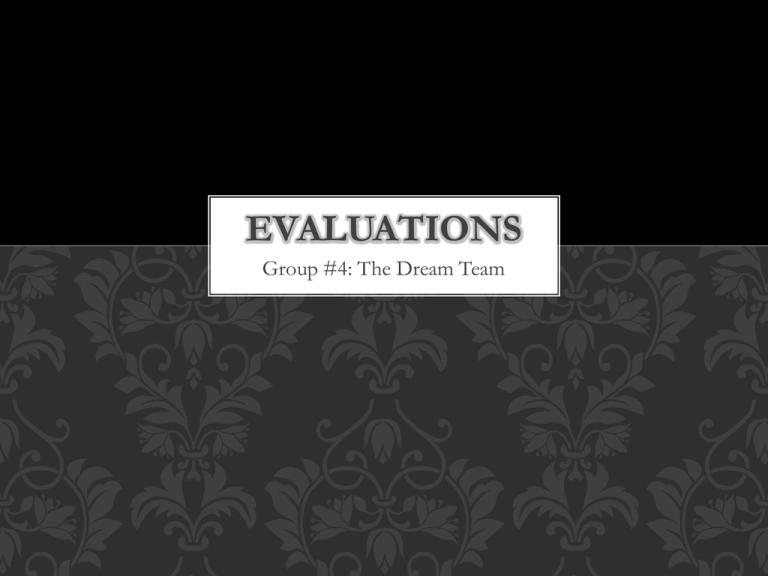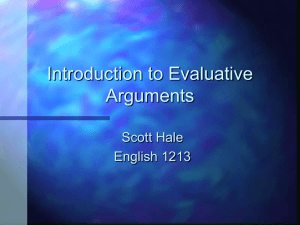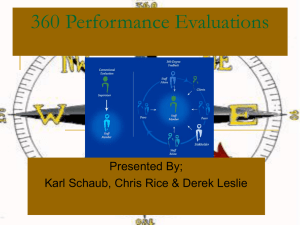Presentation #1
advertisement

EVALUATIONS Group #4: The Dream Team WHAT ARE EVALUATIONS? • Evaluations are known as everyday arguments. • - Ex: Choosing low-fat yogurt and fruit over the pancakes you really love. • You’ve selected dressy clothes because you have a job interview with a firm law. • In both of the examples above, there is applied criteria to a particular problem and then a decision is being made. • Today: Life styles, rituals of praise and blame are a significant part of the American Style • -Ex: Adults who choke at the notion of debating causual or definitional claims will happily spend hours appraising the 49ers, Boston Red Sox, or Detroit Pistons • Beauty pageants and Most Valuable Player awards CRITERIA OF EVALUATION • • Arguments of Evaluation: Produce simple rankings and winners or can lead to profound decisions about our lives, but they always involve some sort of standards. Criteria of Evaluation: Particular standard that are established by humans for judging anything – whether an idea, a work of art, a person, or a product Criteria is sometimes self- evident: • - Ex: A car that gets fifteen miles per gallon is a gas hog. • • • A piece of fish that smells a little off shouldn’t be eaten Serious evaluations always requires reflection, and when we look deeply into our judgments, we sometimes discover important questions that typically go unasked, many prefaced by why: (You challenge the grade you received in a course, but you don’t question the practice of grading) CRITERIA OF EVOLUTION CONT. • Most writers have a hard time grappling with criteria and producing the evaluation. • When you are writing about a particular subject, you want to take time to think about the subject and offer an opinion. • ^ You want readers to learn something from your judgment. • Take a minute to think about “What makes a good veggie burger?” • Even though many people have eaten veggie burgers, they probably haven’t spent much time thinking about them. • But it wouldn’t be enough to claim merely that a proper one should be juicy or tasty – such trite claims are not even interesting. • Criteria of evaluation aren’t static, either. They differ according to time and audience. RESPOND AND DISCUSS Choose one item from the following list that you understand well enough to evaluate. Develop several criteria of evolution that you could defend to distinguish excellence from mediocrity in the area. Then choose an item that you done know much and explain the research you might do to discover reasonable criteria of evolution for it ( Page 218 ). Digital cameras U.S. vice presidents NFL quarterbacks Organic Vegetables Social networking sites Hot water heaters TV journalists Spoken word poetry Video games Athletic shoes Fashion designers Country music bands Navajo rugs Hip-hop bands CHARACTERIZING EVALUATION • There are various types of evidence that help give a better understanding evaluative arguments. • 1. Hard Evidence: facts, statistics, testimony, and other kinds of arguments that can be measured or recorded • 2. Quantitative Arguments: relies on criteria that can be measured, counted, or demonstrated in some mechanical fashion (something is taller, faster, smoother, quieter, or more powerful than something else) • 3. Qualitative Arguments: relies on criteria that must be explained through language and media, relying on such matters as values, traditions, and emotions (some thing is more ethical, more beneficial, more handsome, or more noble than something else) QUANTITATIVE/ QUALITATIVE EVALUATIONS • Quantitative: • Explore in their arguments abstract or complicated issues such as their societal impact, cinematic technique, dramatic structures, intelligent casting, and so on. • Most of these markers of quality could be defined and identified with some precision but not measured or counted. • Making judgments should be easy if all it involves is measuring and counting – and in some cases, that’s the way things work out. • Example: Who’s the tallest or heaviest or loudest person in your class? • If your classmates allow themselves to be • measured, you could find out easily enough, • using the right equipment and internationally sanctioned standards to measurement – the meter, the kilo, or the decibel. • This method is useful, but even the most objective measures have limits. • Qualitative: Make sure to make the case rhetoric By making the case rhetoric…it means convincing the audience to accept the markers of quality you are offering and yet appreciating that they might not. HOW TO DEVELOP AN EVALUATIVE ARGUMENT • It can seem as a simple process, especially if you already know what your claim is likely to be. • Once you have your claim established, you would then explore the implications of your belief. drawing out the reasons, warrants, and evidence that might support it • Example on page 221 FORMULATING CRITERIA • Most people don’t defend their positions until they are challenged (Oh yeah!!!) • Make sure its in great detail/ spend as much time as possible developing your criteria of evaluation • Ask yourself questions such as: Why is a standardized test an unreliable measure of intelligence questions that are relevant to your topic. • You’re most likely to be vague about your beliefs when you haven’t thought (or read) enough about your subject. • Push yourself at least as far as you imagine readers will. • Be certain, too, that your criteria of evaluation apply to more than just your topic of the moment. Your standards should make sense on their own merits and apply across the board. MAKING CLAIMS • When it comes to evaluations, claims can be stated directly or, more rarely, strongly implied • There are examples on pages 223-224 which demonstrate the principle, that qualifications generally make a claim of evaluation easier to deal with and smarter. • The main purpose of qualifying a statement isn’t to make evaluation claims bland but to make them responsible and reasonable. • Share your claims with friends and family PRESENTING EVIDENCE • More evidence= better claim • Just as important as relevance in selecting evidence is presentation • Not all pieces of evidence are equally convincing, nor should they be treated as such • Select the evidence that is most likely to influence your readers. • In evaluation arguments, don’t be afraid to concede a point when evidence goes contrary to the overall claim you wish to make • You can turn a problem into an argument CONSIDERING DESIGN AND VALUES • Visual components play a significant role in many arguments of evaluation, especially those based on quantitative information. • Use visual elements when you are comparing items to one another. • Think of how to persuade the readers • Keep in mind of the basic design features of a text- such as headings for the different criteria using or, in online evaluations, links to material related to your subject inhance your authority and persuasiveness GUIDE • • • • • • • • • Pages 229-233 have a guide which will help you write your evaluation The guide will help you with the following: Finding a topic Researching your topic Formulating a claim Examples of evaluation claims Preparing a proposal Thinking about organization Getting and giving response: Questions for peer response THE END DISCUSSION TIME!! • Read pages 240-241











